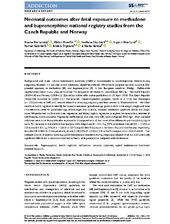| dc.contributor.author | Nechanská, Blanka | en_US |
| dc.contributor.author | Mravčík, Viktor | en_US |
| dc.contributor.author | Skurtveit, Svetlana | en_US |
| dc.contributor.author | Lund, Ingunn Olea | en_US |
| dc.contributor.author | Gabrhelík, Roman | en_US |
| dc.contributor.author | Engeland, Anders | en_US |
| dc.contributor.author | Handal, Marte | en_US |
| dc.date.accessioned | 2019-06-18T11:55:59Z | |
| dc.date.available | 2019-06-18T11:55:59Z | |
| dc.date.issued | 2018 | |
| dc.Published | Nechanská, Mravčík, Skurtveit S, Lund IO, Gabrhelík, Engeland A, Handal M. Neonatal outcomes after fetal exposure to methadone and buprenorphine: national registry studies from the Czech Republic and Norway. Addiction. 2018;113(7):1286-1294 | eng |
| dc.identifier.issn | 0965-2140 | |
| dc.identifier.issn | 1360-0443 | |
| dc.identifier.uri | https://hdl.handle.net/1956/20184 | |
| dc.description.abstract | Background and Aims Opioid maintenance treatment (OMT) is recommended to opioid‐dependent females during pregnancy. However, it is not clear which medication should be preferred. We aimed to compare neonatal outcomes after prenatal exposure to methadone (M) and buprenorphine (B) in two European countries. Design Nation‐wide register‐based cohort study using personalized IDs assigned to all citizens for data linkage. Setting The Czech Republic (2000–14) and Norway (2004–13). [Correction added after online publication on 26 April 2018: The Czech Republic (2000–04) corrected to (2000–14).] Participants Opioid‐dependent pregnant Czech (n = 333) and Norwegian (n = 235) women in OMT who received either B or M during pregnancy and their newborns. Measurements We linked data from health registries to identify the neonatal outcomes: gestational age, preterm birth, birth weight, length and head circumference, small for gestational age, miscarriages and stillbirth, neonatal abstinence syndrome (NAS) and Apgar score. We performed multivariate linear regression and binary logistic regression to explore the associations between M and B exposure and outcomes. Regression coefficient (β) and odds ratio (OR) were computed. Findings Most neonatal outcomes were more favourable after exposure to B compared with M, but none of the differences was statistically significant. For instance, in the multivariate analysis, birth weight was β = 111.6 g [95% confidence interval (CI) = −10.5 to 233.6 and β = 83.1 g, 95% CI = −100.8 to 267.0] higher after B exposure in the Czech Republic and Norway, respectively. Adjusted OR of NAS for B compared with M was 0.94 (95% CI = 0.46–1.92) in the Norwegian cohort. Conclusions Two national cohorts of women receiving opioid maintenance treatment during pregnancy showed small but not statistically significant differences in neonatal outcomes in favour of buprenorphine compared with methadone. | en_US |
| dc.language.iso | eng | eng |
| dc.publisher | Wiley | eng |
| dc.rights | Attribution CC BY-NC-ND | eng |
| dc.rights.uri | http://creativecommons.org/licenses/by-nc-nd/4.0/ | eng |
| dc.subject | Buprenorphine | eng |
| dc.subject | health registries | eng |
| dc.subject | methadone | eng |
| dc.subject | neonatal outcomes | eng |
| dc.subject | opioid maintenance treatment | eng |
| dc.subject | prenatal exposure | eng |
| dc.title | Neonatal outcomes after fetal exposure to methadone and buprenorphine: national registry studies from the Czech Republic and Norway | en_US |
| dc.type | Peer reviewed | |
| dc.type | Journal article | |
| dc.date.updated | 2019-01-30T13:15:20Z | |
| dc.description.version | publishedVersion | en_US |
| dc.rights.holder | Copyright 2018 The Author(s) | |
| dc.identifier.doi | https://doi.org/10.1111/add.14192 | |
| dc.identifier.cristin | 1592352 | |
| dc.source.journal | Addiction | |
| dc.relation.project | Norges forskningsråd: 240197 | |

